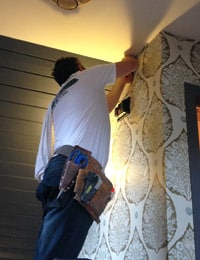How to Hire a Wallcovering Installer
Want to know how to hire a wallcovering installer? First, you'll want to hire an installer with a reputation for excellent work. There are a number of ways to check for this information:
- Use recommendations from friends or neighbors - get references and check them. If possible, go look at finished work.
- Check the Better Business Bureau ratings for wallcovering installers in your area.
- Look for a member of the Wallcovering Installers Association. Members of this association must be craftsmen and women who professionally install wallcoverings.
Second, solicit two or three bids for the work you need. Do not blindly accept the lowest bid. Ask why a bid is as low or high as it is. A higher fee may be worth the extra services or better quality product provided. Make sure you understand precisely what the installer will do and what materials are necessary to complete your project successfully. In comparing prices, be sure you are comparing the same services to be provided.
What Needs to Be in Writing
A professional paperhanger will carefully prepare a comprehensive plan that estimates projects costs based on material, labor and experience specifications. A reputable wallcovering installer will not give you a sketchy, hastily prepared proposal.
You should detail exactly what you want from the installer. This can include protection of your household goods, office equipment and areas surrounding the job site. Specify daily cleanup or cleanup requirements upon completion of the project.
Be certain that you or your decorator specify all the materials to be used. Your installer will do the same so that these details (measurements, pattern names, brand names, quantity, and product information) will be part of the contract.
Make sure both parties understand the financial terms which should be spelled out in the contract. The total price, payment schedule as well as a cancellation penalty (if there is one) should be clear to both parties.
Any warranties should be in writing. Alos, identify warranty as either "Full" or "Limited."
A Full Warranty indicates that all faulty products will be repaired or replaced or otherwise your money will be refunded. A Limited Warranty indicates that the repair or replacement of damaged goods is limited in some way.
Identify the name and address of the person or company offering the warranty. Time frames for all warranties should be clearly specified.
Make sure all changes to the original contract are in writing. Also, make sure all amendments are agreed upon by both parties, before work begins or is continued.
If the contract upon which you and the installer agree is not complete to your exact specifications, do not sign it. Make sure you understand fully all terms as well as conditions. Affirm that you are getting exactly what you want, that you know the cost of each item/service and that you’re paying a fair price.
Finally, don't hesitate to ask your professional paperhanger to provide certification of insurance covering worker's compensation, property damage, and personal liability. Career wallcovering installers insured for the kind of work they do. This request is easily met.
Members of the Association recognized as quality wallcoverings installers. Many considered artisans, craftsman as well as women. For a referral to an Association member in your area, you may search via our Find a Paperhanger Feature.
EPA Lead Ruling Takes Effect in 2010
Hazards of lead-based paint can affect anyone. However, children under the age of six (6) have a significantly higher risk. On April 22, 2010, the US Environment Protection Agency’s (EPA) new Renovation, Repair, and Painting Rule became effective as well as enforceable. This new Federal regulation is intended to protect children and adults during renovation, repair and painting projects in pre-1978 housing and child-occupied facilities (such as daycare centers) where lead-based paint will be disturbed by the work. Children exposed to lead at an early age are likely to suffer from a variety of permanent conditions including brain, liver and also kidney damage, slowed development, learning disabilities, behavior problems, lowered intellect, hearing loss and/or restlessness. (https://www.epa.gov/lead/pubs/chancefactsheet.pdf)
What is WIA doing in response to the new EPA Rule?
WIA member companies are encouraged to take the required EPA Certified Renovator training courses in a cooperative partnership between WIA Headquarters as well as EPA-accredited trainers. These partnerships will assure that WIA members have access to the required training in compliance with new Federal requirements. Additionally, WIA is working to promote lead-safe work practices during wallcovering, decorating, remodeling, renovation and maintenance projects in pre-1978 housing. We are educating our members as well as the general public through various marketing resources including WIA’s website, direct mail and other avenues.
How does this ruling affect consumers?
Consumers need to know how they can find a qualified professional for these services. Wallcovering and painting contractors, who perform work in pre-1978 housing and child-occupied facilities, may need to apply to the EPA to become "Certified Renovation Firms." However, the law does not affect jobs that come under the EPA rule of "minor repairs", for example, those jobs involving less than 6 square feet of disturbed paint per room. If less than 6 square feet of paint per room is disturbed, the installer is not required by the EPA to use lead-safe practices, is not required to be EPA certified and is not required to give out the EPA's "Renovate Right" booklet at the time of the job estimate. (www.epa.gov/fedrgstr/EPA-TOX/2008/April/Day-22/t8141.htm)
Additionally, contractors and their workers need to take courses from EPA-accredited training providers. This is to become "Certified Renovators." Member companies of WIA should be the consumer’s first choice. Find a WIA member company near you online via WIA’s Find-A-Professional.
Where can consumers find more information?
The EPA’s website is the best source of information for consumers about the new Renovation, Repair, and also Painting Rule requirements. Visit www.epa.gov/lead/pubs/renovation.htm for complete details on current regulations. They provide valuable resources including several PDF pamphlets on lead, lead-based paint, lead poisoning and also steps to perform renovations in pre-1978 housing and child-occupied facilities.
The National Lead Information Center (NLIC) can also be a valuable resource about lead. NLIC is reachable at 1(800) 424-LEAD (5323) Monday through Friday from 8 am to 6 pm. Consumers may also submit an inquiry online to NLIC at www.epa.gov/lead/pubs/nlic.htm.
Consumers can find a WIA member company in their area as well as with Find a Professional directory. Learn more about WIA by calling (800) 254-WIA or also emailing us at [email protected].



